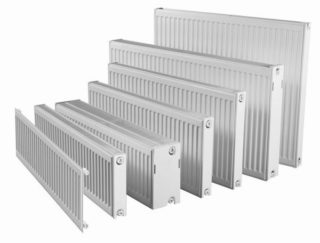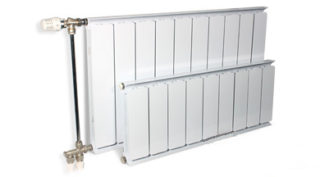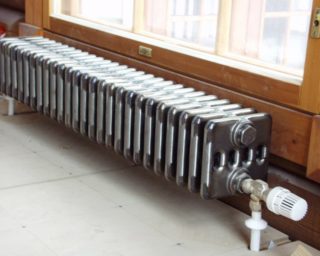The appropriate dimensions of heating radiators are determined primarily not by appearance, but by the influence of dimensions on heat transfer. Also, these parameters and the location of the heating elements in the space of the room determine how evenly the heat will be distributed.
Radiator Selection Requirements
When choosing the dimensions of heating batteries for placement under a window, it is necessary to proceed from the values of the width of the window opening and the estimated distance of the edges of the elements to the windowsill and floor surface. Before going to the store, you must make all the necessary measurements and focus on them when considering options. The standard indicator of the opening width is 110-120 cm. The size of the purchased battery should be at least 70-75% of this value. If we are talking about a sectional device made of aluminum, you will need a radiator of 10-12 elements (the width of one is usually about 8 cm).
When choosing the sizes of radiators, the height of the windowsill should be taken into account. Between it and the top edge of the radiator elements there should be a distance of 6-12 cm. The height of the heating devices above the floor should be at least 8 cm. In this case, heat transfer is achieved that is as much as possible declared by the manufacturer.
Also, in the private sector, the volume of liquid placed in the section is of great importance. If in apartment buildings, the residents of which use centralized heating, this parameter does not play a role, then when using your own system it is needed to calculate the volume when you need to find out the efficiency of the pump or boiler.
The most important indicator when choosing heating equipment is thermal power. It is far from always advisable to choose high-power options. In dwellings with high-quality thermal insulation, a model with an average value of this parameter is enough.
Since the surface area of the radiator affects the uniformity of heat transfer, it is better to choose a larger number of sections with medium power than less with high power. This will ensure that there are no cold zones and condensation settling on the window pane.
Terminology
Documentation examining the dimensions of heating radiators often refers to center distance. This parameter indicates the length of the gap from the center point of one connecting hole to a similar place in another. Sometimes this value is called the interaxal or inter-nipple distance. If the pipelines supplying the radiator are in working condition and it is not planned to change them, the purchased new heater should have the same center-to-center indicator as the old one so that it does not have to make changes to the wiring. Sometimes the names of models - both Russian and foreign - contain three-digit numbers. They denote this parameter in millimeters (for example, Modern 500).
Linear dimensions include:
- the mounting height of the radiator - it must be selected so as to provide the required distances to the windowsill and floor;
- depth
- width - for models with a sectional structure, it, like the previous parameter, also refers to the dimensions of the elements, but if the depth of the radiator and its individual sections is the same, to calculate the total width, multiply the index of an individual unit by their number and add about 1-2 cm, attributable to gaskets.
Knowing the linear parameters of the radiator, you can purchase a protective screen for it.When mounting floor flat options, dimensions are important for selecting the right components for the heating system.
Standard heatsink heights
When considering the height of a typical heating battery, an inter-center figure of 50 cm is implied. Such models can be recognized by the number 500 in the name. They are taken as a reference point because Soviet cast iron radiators had such a height value. Thick-walled products from this material are very durable - in many houses they successfully perform their functions to this day. To avoid alterations to the existing system, consumers are trying to find batteries with identical significant dimensions. Suitable for center distance models are made from different materials.
Cast iron
Cast iron models on the market are available in a wide range of parameters. An accordion of 50 cm is recognized by the letters MC and a two- or three-digit number, which indicates here not the center distance, but the depth of the product. It ranges from 85 to 140 mm. The width varies from one model to another and takes different values from the manufacturers of one model: for example, the MC-140 is available in versions of 108 and 93 mm.
In addition to the accordion, the interaxal 50 cm are also found in other products, for example, sectional structure. Some of them are equipped with legs. There are models in which the depth is not indicated due to the expanded form down.
Aluminum
Dimensions of aluminum radiators are characterized by greater standardization. Here you can indicate the average values. If we are talking about the dimensions of aluminum heating radiators with an interaxial parameter of 50 cm, the typical section height will vary in the range 57-58.5 cm. The width is usually 8 cm. The depth is more variable - there are flattened options (for example, the domestic "Termal" with 5.2 cm), but for most it is within the range of 8 to 10 cm.
Among bimetallic radiators, flat models are not found. The linear parameters of these products also do not possess large variability of values. The width of one section of the bimetallic radiator is 8-8.7 cm, the height is 56.5-57.5 cm, the depth is 8-9.5 cm. Low models of bimetal are a rare case. The minimum height is 20 cm.
Steel
Steel products are less frequently produced than others with an interaxle parameter corresponding to a standard accordion. However, such products are found on the market even among foreign manufacturers. The Kermi brand designed a steel panel model specifically for use as a replacement for old cast iron radiators. Domestic company "Conrad" also produces batteries for this task - RSV-1. There are samples of suitable sizes with a tubular structure. But usually, as a key parameter, they indicate the total mounting height per connection from the bottom.
Tall and narrow radiators
Heating units of this kind attract consumers by introducing an element of unusualness into the interior. Although in most cases a large-height model cannot be placed under a window sill, by itself it looks non-standard and provides room for design solutions. The radiator can be painted, combined with a shelf or cabinet. The main thing is not to have materials emitting toxic fumes when heated near it, and to take a responsible approach to the choice of the coloring composition.
Elongated batteries hardly produce any metals. It should be mentioned cast iron, the models of which do not exceed a meter in height. Bimetallic goods are even lower - here the peak value is approximately 86 cm. Most of the common high aggregates are made of steel. These may be tubular designs and panel samples.In some of them, the height may exceed 2 meters (for example, Verteo Plan). Such models are designed for connection from the bottom. For panel options, there is both a flat and profiled surface. Many manufacturers of this type of equipment provide services for the manufacture of radiators for private orders.
Low and flat radiators
Low are considered to be models that have an interaxle index less than 40 cm. This segment is characterized by a wide variety of products, since miniature batteries are made from different materials. Among Russian buyers, they are not so much in demand, since the radiator can not be replaced by an accordion without costly modifications to the design of the heating system.
Among the cast-iron products, subminiature models are not found. An extreme option is a Bolton radiator with a center-distance measurement of 220 mm and an installation height of 33 cm. For other small cast iron devices, these parameters are in the region of 300-350 mm and 35-40 cm, respectively.
Aluminum devices have a minimum center distance of 200 mm. There are many options of this size on the market. You can recall the company Global, Sira and the domestic "Rifar". The same companies produce low models of bimetal (with a height of about 25 cm). Somewhat larger aluminum models (300-400 mm) are found in any manufacturer that produces heating devices. Miniature, but powerful and expensive batteries made of copper or its alloy with aluminum usually have a height of 20-22 cm, but there are specimens that go beyond the low category.
Miniature non-planar radiators are made of steel by Purmo. This includes two panel models with a center distance of 15 cm. The same or slightly larger (by 1-3 cm) figure in a number of tubular products. And yet, in most steel batteries, this value exceeds 25 cm. On the market you can find low, but long structures (up to 2 meters in length).
In some conditions, the placement of even a miniature radiator in a room is impractical and contrary to safety standards. An example is the corridors of escape routes - they are not supposed to mount devices that extend beyond the surface of the wall at a height of less than 2 meters. For such cases, as well as to save space in the room, the output will be a convector, which is built into the floor structure. Such a device can be called the lowest radiator. They are available in a wide range of power values. They are used as the sole source of heating or in addition to another method. Convectors are also installed for heating continuous glazing.
There are cases when the critical (in terms of minimization) parameter is depth, not height. Then it is supposed to consider a segment of flat models. Bimetallic and cast iron samples in this case are not suitable due to the large depth. The Russian version of aluminum is Zlatoust products with an indicator of 52 mm. Models for replacing the accordion and low are made with a center distance of 30 cm. They have high thermal power. Panel batteries with a depth of 6 cm are also suitable.
The selection of a model with suitable dimensions is made taking into account the internal layout and purpose of the room and the configuration of the existing heating system. There are times when it is advisable to choose a radiator with the lowest indicator of height or depth.









